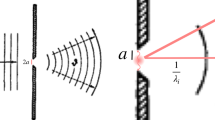Abstract
An increasing number of experiments at the Belle, BNL, CERN, DAΦNE and SLAC accelerators are confirming the violation of time reversal invariance (T). The violation signifies a fundamental asymmetry between the past and future and calls for a major shift in the way we think about time. Here we show that processes which violate T symmetry induce destructive interference between different paths that the universe can take through time. The interference eliminates all paths except for two that represent continuously forwards and continuously backwards time evolution. Evidence from the accelerator experiments indicates which path the universe is effectively following. This work may provide fresh insight into the long-standing problem of modeling the dynamics of T violation processes. It suggests that T violation has previously unknown, large-scale physical effects and that these effects underlie the origin of the unidirectionality of time. It may have implications for the Wheeler-DeWitt equation of canonical quantum gravity. Finally it provides a view of the quantum nature of time itself.
Similar content being viewed by others
References
Price, H.: Time’s Arrow and Archimedes’ Point. Oxford University Press, New York (1996)
Aharony, A.: Microscopic irreversibility in the neutral kaon system and the thermodynamical arrow of time I. CPT symmetric case. Ann. Phys. 67, 1–18 (1971)
Aharony, A.: Microscopic irreversibility in the neutral kaon system and the thermodynamical arrow of time II. CPT violating case. Ann. Phys. 68, 163–171 (1971)
Berger, Ch., Sehgal, L.M.: CP violation and arrows of time: evolution of a neutral K or B meson from an incoherent to a coherent state. Phys. Rev. D 76, 036003 (2007)
Christenson, J.H., Cronin, J.W., Fitch, V.L., Turlay, R.: Evidence for the 2π decay of the \(K_{2}^{0} \) meson. Phys. Rev. Lett. 13, 138–140 (1964)
Sakharov, A.D.: Violation of CP symmetry, C asymmetry and baryon asymmetry of the universe. JETP Lett. 5, 24–26 (1967)
Pavlopoulos, P.: CPLEAR: an experiment to study CP, T and CPT symmetries in the neutral-kaon universe. Nucl. Phys. B 99, 16–23 (2001)
Lusiani, A.: Tests of T and CPT symmetries at the B-factories. J. Phys. Conf. Ser. 171, 012037 (2009)
Angelopoulos, A., et al. (CPLEAR Collaboration): First direct observation of time-reversal non-invariance in the neutral-kaon universe. Phys. Lett. B 444, 43–51 (1998)
Cabibbo, N.: Unitary symmetry and leptonic decays. Phys. Rev. Lett. 10, 531–533 (1963)
Kobayashi, M., Maskawa, T.: CP-violation in the renormalizable theory of weak interaction. Prog. Theor. Phys. 49, 652–657 (1973)
Wigner, E.P.: Group Theory and Its Application to the Quantum Mechanics of Atomic Spectra. Academic Press, New York (1959)
The Belle Collaboration: Difference in direct charge-parity violation between charged and neutral B meson decays. Nature 452, 332–335 (2008)
Feynman, R.P.: Space-time approach to non-relativistic quantum mechanics. Rev. Mod. Phys. 20, 367–387 (1948)
Barnett, S.M., Vaccaro, J.A.: The Quantum Phase Operator: A Review. Taylor & Francis, London (2007)
Lee, T.D., Wolfenstein, L.: Analysis of CP-noninvariant interactions and the \(K_{1} ^{0}\), \(K_{2} ^{0}\) system. Phys. Rev. 138, B1490–B1496 (1965)
Rosenband, T., et al.: Frequency ratio of Al+ and Hg+ single-ion optical clocks; metrology at the 17th decimal place. Science 319, 1808–1812 (2008)
Bennett, C.L.: Cosmology from start to finish. Nature 440, 1126–1131 (2006)
Kofman, L., Linde, A., Starobinsky, A.A.: Reheating after Inflation. Phys. Rev. Lett. 73, 3195–3198 (1994)
Misner, C.W.: Feynman quantization of general relativity. Rev. Mod. Phys. 29, 497–509 (1957)
Tolman, R.C.: On the use of the energy-momentum principle in general relativity. Phys. Rev. 35, 875–895 (1930)
Tryon, E.P.: Is the universe a vacuum fluctuation? Nature 246, 396 (1973)
Hartle, J.B., Hawking, S.W.: Wave function of the universe. Phys. Rev. D 28, 2960 (1983)
DeWitt, B.S.: Quantum theory of gravity. I. The canonical theory. Phys. Rev. 160, 1113 (1967)
Alvarez, E.: Quantum gravity: an introduction to some recent results. Rev. Mod. Phys. 61, 561 (1989)
Suzuki, M.: On the convergence of exponential operators—the Zassenhaus formula, BCH formula and systematic approximants. Commun. Math. Phys. 57, 193–200 (1977)
Yao, W.-M., et al.: Review of particle physics. J. Phys. G, Nucl. Part. Phys. 33, 666–684 (2006)
Author information
Authors and Affiliations
Corresponding author
Rights and permissions
About this article
Cite this article
Vaccaro, J.A. T Violation and the Unidirectionality of Time. Found Phys 41, 1569–1596 (2011). https://doi.org/10.1007/s10701-011-9568-x
Received:
Accepted:
Published:
Issue Date:
DOI: https://doi.org/10.1007/s10701-011-9568-x




